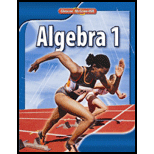
Concept explainers
(a)
To find:The experimental probability that a customer will win.
(a)
Answer to Problem 67STP
The experimental probability that a customer will win is
Explanation of Solution
Given information:
A local movie theater has advertised that one out of four customers will receive a free popcorn with the purchase of a movie ticket. So far,
Calculation:
In an experiment,
The experimental probability is the ratio of the number of favorable outcomes to the number of total outcomes.
So, the experimental probability that a customer will win is,
Therefore, the experimental probability that a customer will win is
(b)
To find: The theoretical probability that a customer will win.
(b)
Answer to Problem 67STP
The theoretical probability that a customer will win is
Explanation of Solution
Given information:
A local movie theater has advertised that one out of four customers will receive a free popcorn with the purchase of a movie ticket. So far,
Calculation:
Since, one out of four customers will receive a free popcorn with the purchase of a movie ticket.
The theoretical probability is the ratio of the number of favorable outcomes to the number of total outcomes.
So, the theoretical probability that a customer will win is,
Therefore, the theoretical probability that a customer will win is
(c)
To find: The difference between theoretical and experimental probability that a customer will win.
(c)
Answer to Problem 67STP
The difference between theoretical and experimental probability that a customer will win is
Explanation of Solution
Given information:
A local movie theater has advertised that one out of four customers will receive a free popcorn with the purchase of a movie ticket. So far,
Calculation:
As calculated in part (a), the experimental probability that a customer will win is
As calculated in part (b), the theoretical probability that a customer will win is
The difference between theoretical and experimental probability is,
Therefore, the difference between theoretical and experimental probability that a customer will win is
Chapter 1 Solutions
Algebra 1
Additional Math Textbook Solutions
College Algebra with Modeling & Visualization (5th Edition)
Algebra and Trigonometry (6th Edition)
Pre-Algebra Student Edition
A Problem Solving Approach To Mathematics For Elementary School Teachers (13th Edition)
A First Course in Probability (10th Edition)
Basic Business Statistics, Student Value Edition
- Solve the following system of equations: 50x+20y=1800 10x+3y=300arrow_forward> > > we are hiring Salesforce Admin Location: Remote Key Responsibilities: Administer Salesforce Sales & Revenue Cloud (CPQ & Billing) Configure workflows, validation rules & dashboards Automate processes using Flows & Process Builder Collaborate with Sales, Finance & Marketing teams Manage user roles & security Apply: Hr@forcecraver.comarrow_forwardAnswer this questionarrow_forward
- 1. vector projection. Assume, ER1001 and you know the following: ||||=4, 7=-0.5.7. For each of the following, explicitly compute the value. འབ (a) (b) (c) (d) answer. Explicitly compute ||y7||. Explain your answer. Explicitly compute the cosine similarity of and y. Explain your Explicitly compute (x, y). Explain your answer. Find the projection of onto y and the projection of onto .arrow_forward2. Answer the following questions using vectors u and v. --0-0-0 = find the the cosine similarity and the angle between u and v. འརྒྱ (a) (b) find the scalar projection of u onto v. (c) find the projection of u onto v. (d) (e) (f) find the scalar projection of onto u. find the projection of u onto u. find the projection of u onto and the projection of onto . (Hint: find the inner product and verify the orthogonality)arrow_forwardPlease type out answerarrow_forward
- The function f(x) = log x is transformed to produce g(x) = log (x) – 3. Identify the type of transformation and describe the change. Please type out answerarrow_forwardEach graph below is the graph of a system of three linear equations in three unknowns of the form Ax = b. Determine whether each system has a solution and, if it does, the number of free variables. A. O free variables ✓ B. no solution C. no solution D. no solution E. 1 free variable F. 1 free variablearrow_forwardSolve the following systems of equations and show all work.y = x2 + 3y = x + 5 Please type out answerarrow_forward
 Algebra and Trigonometry (6th Edition)AlgebraISBN:9780134463216Author:Robert F. BlitzerPublisher:PEARSON
Algebra and Trigonometry (6th Edition)AlgebraISBN:9780134463216Author:Robert F. BlitzerPublisher:PEARSON Contemporary Abstract AlgebraAlgebraISBN:9781305657960Author:Joseph GallianPublisher:Cengage Learning
Contemporary Abstract AlgebraAlgebraISBN:9781305657960Author:Joseph GallianPublisher:Cengage Learning Linear Algebra: A Modern IntroductionAlgebraISBN:9781285463247Author:David PoolePublisher:Cengage Learning
Linear Algebra: A Modern IntroductionAlgebraISBN:9781285463247Author:David PoolePublisher:Cengage Learning Algebra And Trigonometry (11th Edition)AlgebraISBN:9780135163078Author:Michael SullivanPublisher:PEARSON
Algebra And Trigonometry (11th Edition)AlgebraISBN:9780135163078Author:Michael SullivanPublisher:PEARSON Introduction to Linear Algebra, Fifth EditionAlgebraISBN:9780980232776Author:Gilbert StrangPublisher:Wellesley-Cambridge Press
Introduction to Linear Algebra, Fifth EditionAlgebraISBN:9780980232776Author:Gilbert StrangPublisher:Wellesley-Cambridge Press College Algebra (Collegiate Math)AlgebraISBN:9780077836344Author:Julie Miller, Donna GerkenPublisher:McGraw-Hill Education
College Algebra (Collegiate Math)AlgebraISBN:9780077836344Author:Julie Miller, Donna GerkenPublisher:McGraw-Hill Education





